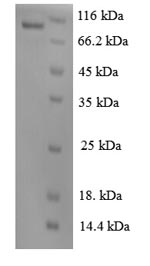The DNA fragment encoding the 20-764aa of the human KDR protein was fused with N-terminal GST tag gene and then was inserted into the expression vector, which was subsequently transformed into the E.coli for expression. The resulting product was further purified to obtain the recombinant human KDR protein. The purity of this recombinant KDR protein is greater than 90% assessed by Bandscan software analysis combined with SDS-PAGE. This KDR protein showed a band on the gel with a molecular weight of approximately 105 kDa.
As a VEGF receptor, VEGFR-2 (also known as KDR, FLK1, CD309) is a type IV receptor tyrosine kinase. It plays major part in the regulation of VEGF-induced endothelial proliferation, survival, migration, tubular morphogenesis and sprouting. In addition, KDR has been found closely related with the SHC2, Annexin A5, SHC1. The signaling involved in the KDR include Rab GTPase, P2Y purine nucleotide receptor, integrin alphaVbeta3, T-cell protein tyrosine phosphatase, etc. KDR exerts multiple biological effects through its interaction with other molecules. Of note, more researches suggested that KDR participates in the tumor growth and metastasis.







